The Kiewitz Shale bed of the Stoner Limestone Member of the Stanton Formation is what geologists call offshore shale. That is, it was deposited in deeper, colder and less well oxygenated water than a near shore shale. The brachiopods from the Kiewitz shale contain many of the same species that are found in the Stull shale. There is a difference, however, inasmuch as the ones from the Kiewitz shale are usually a bit smaller and have thinner, less ornamented shells than the ones from the Stull shale. Neochonetes granulifer (Owen) is very abundant in the Kiewitz shale and Robert Lindsay, a graduate student at the University of Nebraska in 1971, described the Kiewitz shale as being a Neochonetes dominated community.
Atrypoid brachiopods
Atrypoid brachiopods are similar to spiriferoid brachiopods inasmuch as they also have spiralia. Atrypoid brachiopods, however, have short hinge lines and their shells may be either smooth or plicated.
Note on Composita: In their classic 1932 study "Brachiopoda of the Pennsylvanian System in Nebraska" Carl O. Dunbar and George E. Condra recorded at least four species of Composita from Nebraska. These are shown in the illustrations for your reference. Subsequent workers such as Norman Newell in Kansas and Myron Sturgeon and Richard Hoare in Ohio continued to recognize the species that were recognized or erected by Dunbar and Condra. Anne Lutz-Garihan studied a large number of Composita from the early Permian strata of Kansas and Oklahoma and showed that the genus was represented by an intergradational series of individuals that varied morphologically between two end members and none could be separated into groups that could be interpreted as separate species. Further, Lutz-Garihan showed that the end members did not differ in abundance and distribution in rock types, stratigraphic horizons or geographic areas and could not be explained as ecophenotypes, evolutionary populations or subspecies. Although Composita and its species have not been studied in the same detail as Lutz Garrihan's material, the genus shows a great variation in the Stull Shale of Nebraska, Iowa and Kansas.
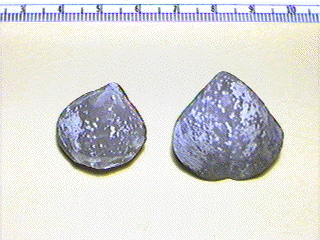
Composita subtilita
Description: "Composita subtilita" (Hall) is very common in the Kiewitz shale. The tiny white dots are made of a concentrically banded silica. This form of silica is often called "beekite" and it should not be confused with agate which formed in hollows or voids in the rock. Images by Ed Schafer; specimens from Bill Rushlau.
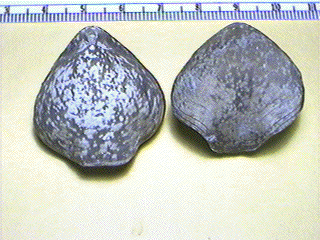
Composita subtilita
Description: "Composita subtilita" (Hall) is very common in the Kiewitz shale. The tiny white dots are made of a concentrically banded silica. This form of silica is often called "beekite" and it should not be confused with agate which formed in hollows or voids in the rock. Images by Ed Schafer; specimens from Bill Rushlau.
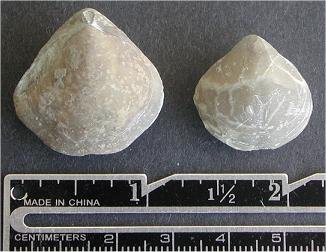
Composita ovata
Description: "Composita ovata" (Mather), 1915, ventral (left) and dorsal views
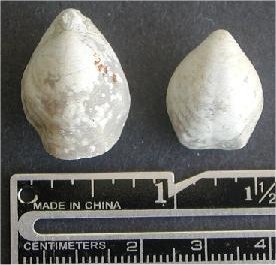
Composita elongata
Description: "Composita elongata" (Dunbar and Condra), 1932, ventral (left) and dorsal views
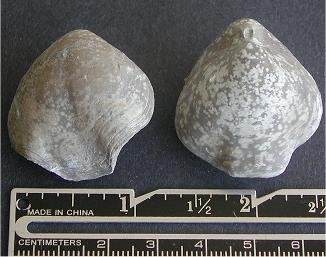
Composita trilobata
Description: "Composita trilobata" (Dunbar and Condra), 1932, dorsal (left) and ventral views
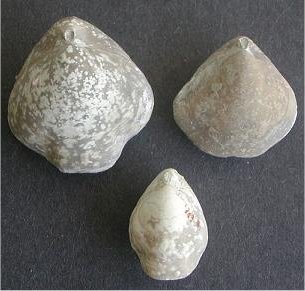
Composita sp.
Description: "Composita sp.", showing gradation from "C. elongata" to "C. ovata" to "C. trilobata"
Strophomenoid brachiopods
These brachiopods can become rather large, some having shells of 75 mm (3 inches) in diameter. Their pedicle opinings are usually filled with small calcite plates. Strophomenoid brachiopods probably remained immobile in the mud into which the extended their long, steeple-like beaks. The valves are commonly flattened toward the anterior and they have a circular outline with very fine costae. These brachiopods often have very well developed muscle scars on their interiors. Derbyia, Schuchertella and Streptorhynchus appear to be the most common genera of strophomenoid brachiopods in Nebraska.
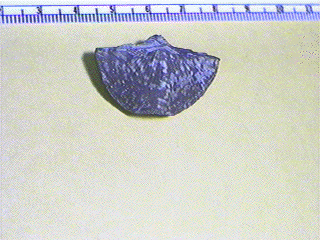
Neospirifer triplicatus
Description: "Neospirifer triplicatus" (Hall) is the dominant spiriferoid brachiopod in the Kiewitz Shale. Neospirifer may appear to be a fully grown "Punctospirifer" but the latter has punctae (tiny little holes) covering its valves. Image by Ed Schafer; specimens from Bill Rushlau.
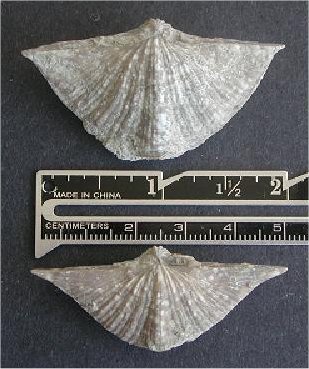
Neospirifer triplicatus
Description: "Neospirifer triplicatus" (Hall), 1852 (above) and "N. triplicatus" var. "alatus" (Dunbar and Condra), 1932 (below)
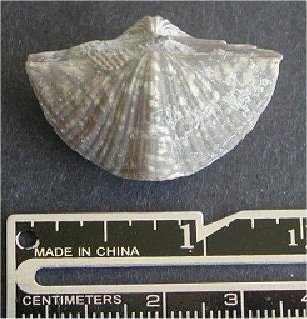
Neospirifer triplicatus
Description: "Neospirifer triplicatus" (Hall), 1852
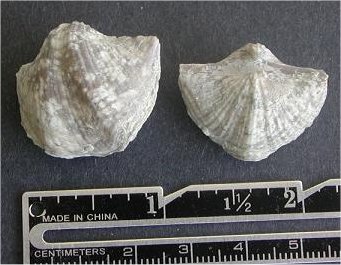
Neospirifer sp. cf. N. latus
Description: "Neospirifer sp. cf. N. latus" (Dunbar and Condra), 1932
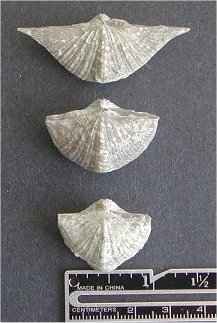
Neospirifer sp.
Description: "Neospirifer sp." three shells showing gradation in morphology
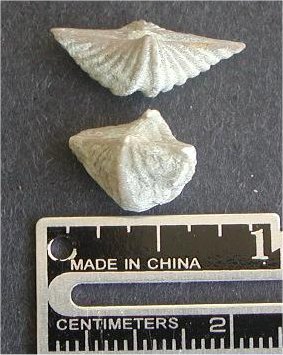
Punctospirifer kentuckyensis
Description: "Punctospirifer kentuckyensis" (Shumard), 1852
Chonetoid brachiopods
Chonetoid brachiopods are typified by having nearly semi-circular shells with flat to only slightly inflated brachial and pedicle valves. They have spines along the hinge line of the pedicle valve and the pedicle opening is closed up with tiny plates. Chonetoid brachiopods appear to be most common in fairly muddy water environments. They may have fixed themselves to the substrate by sinking their spines in the muddy bottom. There are a number of genera of chonetoid brachiopods with the suffix "---chonetes" which should be pronounced "cone eat ease".
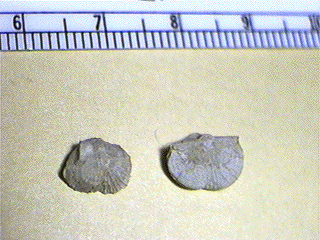
Streptorhynchus affie
Description: "Streptorhynchus affie" Girty appears to be a fairly short ranging species and most of the known examples have been collected from the Kiewitz shale along the lower Platte River valley. Its' elongated beak may have simply been pushed into the substrate to anchor the shell. Image by Ed Schafer; specimens from Bill Rushlau.
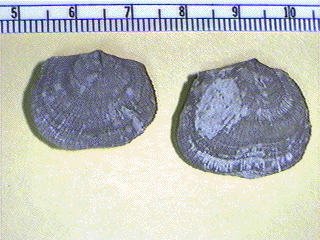
Derbyia crassa
Description: "Derbyia crassa" (Meek & Hayden) is fairly common in the deposits of the Missouri series of the late Pennsylvanian that are exposed along the lower Platte River valley. This species was one of the first to be named by pioneer geologists F. B. Meek and F. V. Hayden in 1858 in Nebraska. Image by Ed Schafer; specimens from Bill Rushlau.
Productoid brachiopods
Productoid brachiopods are characterized by having highly inflated, and spinose pedicle valves, long hinge lines, and large beaks. The spines may be several inches long. Some genera such as Antiquatonia have but a few robust spines whereas others such as Pulchratia have numerous, fine spines. Some productoid brachiopods probably settled into a soft substrate by imbedding their spines in the soft substrate whereas some productoids appear to have cemented their spines to a hard object in the substrate. There are several distinct species of productoids in the Pennsylvanian of the mid-continent. Growth series have generally not been constructed for many of these brachiopods so it is not known which "species" are valid and which are growth stages of a described species.
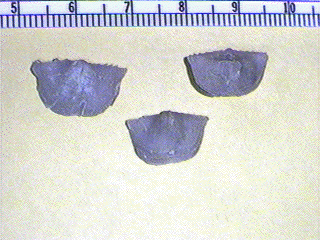
Neochonetes granulifer
Description: "Neochonetes granulifer" (Owen) is the species on which Robert Lindsay based a "Neochonetes" community that is based on the abundance of these brachiopod in the Kiewitz shale. Neochonetes granulifer specimens have half round, flat shells whose brachial valves have small spines along the hinge line. Image by Ed Schafer; specimens from Bill Rushlau.
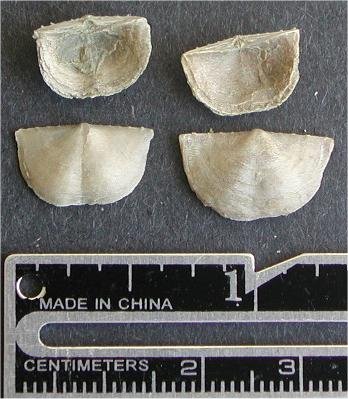
Neochonetes granulifer
Description: "Neochonetes granulifer" (Owen), 1852, dorsal (above) and ventral views. Note worm tube attached to example in upper left corner.
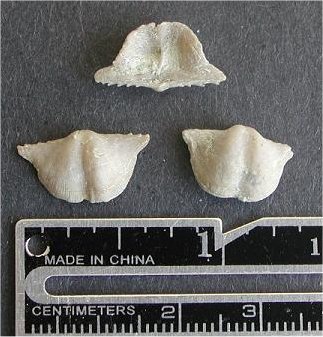
Chonetinella verneuiliana
Description: "Chonetinella verneuiliana" (Norwood and Pratten), 1855, ventral (above) and dorsal views (below)
Bivalves (Clams) from the Kiewitz Shale
These are characterized by having ovate, smooth shells with pedicle openings. See the examples of recent brachiopods from New Zealand. Most extant brachiopods are terebratuloids, which appear to be closely related to such forms as the atrypoid brachipods such as Composita. Such is not the case. The former has its food gathering system supported by a large, single loop inside the shell whereas the latter has it food gathering system supported by spiralia.

Neospirifer triplicatus
Description: "Neospirifer triplicatus" (Hall) is the dominant spiriferoid brachiopod in the Kiewitz Shale. Neospirifer may appear to be a fully grown "Punctospirifer" but the latter has punctae (tiny little holes) covering its valves. Image by Ed Schafer; specimens from Bill Rushlau.

Neospirifer triplicatus
Description: "Neospirifer triplicatus" (Hall), 1852 (above) and "N. triplicatus" var. "alatus" (Dunbar and Condra), 1932 (below)

Neospirifer triplicatus
Description: "Neospirifer triplicatus" (Hall), 1852

Neospirifer sp. cf. N. latus
Description: "Neospirifer sp. cf. N. latus" (Dunbar and Condra), 1932

Neospirifer sp.
Description: "Neospirifer sp." three shells showing gradation in morphology

Punctospirifer kentuckyensis
Description: "Punctospirifer kentuckyensis" (Shumard), 1852